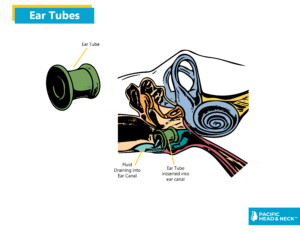Ear tubes are tiny cylinders placed through the ear drum (tympanic membrane) to allow air into the middle ear. They also may be called tympanostomy tubes, myringotomy tubes, ventilation tubes, or PE (pressure equalization) tubes.
These tubes can be made out of various materials and come in two basic types: short-term and long-term. Short- term tubes are smaller and typically stay in place for six to eighteen months before falling out on their own. Long-term tubes are larger and have flanges that secure them in place for a longer period of time. Long-term tubes may fall out on their own, but removal by an otolaryngologist may be necessary.
Ear infections are a rite of passage for children and by the age of five, nearly every child has experienced at least one. Most ear infections either resolve on their own (viral) or are effectively treated by antibiotics (bacterial). But sometimes ear infections and/or fluid in the middle ear may become a chronic problem leading to other issues, such as hearing loss, poor school performance, or behavior and speech problems. In these cases, insertion of an ear tube by an otolaryngologist (Ear, Nose, and Throat Specialist) may be considered.

Diagnosis
Who needs Ear Tubes?
- Ear tubes are often recommended when a person experiences repeated middle ear infection (acute otitis media) or has hearing loss caused by persistent middle ear fluid (otitis media with effusion). These conditions most commonly occur in children, but can also be present in teens and adults and can lead to speech and balance problems, hearing loss, poor school performance, or changes in the structure of the ear drum. Other less common conditions that may warrant the placement of ear tubes are malformation of the ear drum or eustachian tube, down syndrome, cleft palate, and barotrauma (injury to the middle ear caused by a reduction of air pressure, usually seen with altitude changes as in flying and scuba diving).
Each year, more than half a million ear tube surgeries are performed on children, making it the most common childhood surgery performed with anesthesia. The average age for ear tube insertion is one to three years old. Inserting ear tubes may:
- Reduce the risk of future ear infection
- Restore hearing loss caused by middle ear fluid
- Improve speech problems and balance problems
- Improve behavior and sleep problems caused by chronic ear infections
Frequently Asked Questions
- Fluid that has not cleared for a long period of time (at least 3-4 months) can concentrate into a "glue ear" causing some degree of reversible hearing loss.
- Multiple ear infections that have not been adequately controlled with medical treatment.
- Severe retraction or distortion of the ear drum.
- Pressure problems (barotrauma as from SCUBA diving, airplane flight, or hyperbaric oxygen treatment)
- The ear tubes are put in by making a small incision in the ear drum and inserting the tube through this incision. For adults the procedure can usually be done in the clinic with a local anesthetic. Since the surgery is very precise, the patient must be very still during the operation. For children, the operation is therefore often done in the operating room with a light general anesthetic.
- Our physicians recommend water precautions or ear plugs before the ears are submerged in water (shower, diving, aggressive swimming). You are allowed to bathe, hair washing, surface swimming, or ocean exposure (without any precautions). Diving deeper under water, or swimming in (dirtier) lakes and rivers is more likely to cause infections. In those cases, the preventative use of certain antibiotic ear drops (such as Floxin Otic) may help. It is always safer to keep the ear dry.
Over 90% of the time, tubes extrude spontaneously. If the tube has remained in the ear for several years or if the tube is causing infections, the tube may be removed. Depending on the patient, the removal of the tube(s) may require general anesthesia.
The patient should see the doctor every 6 months for a tube check or until the ears are normal.
If the ear drum remains normal, and there is no re-accumulation of fluid, there may be no need for intervention. On the other hand, if the ear is symptomatic, and the tube is plugged, one of several drops may be recommended. Rarely, the tube will need to be replaced.








